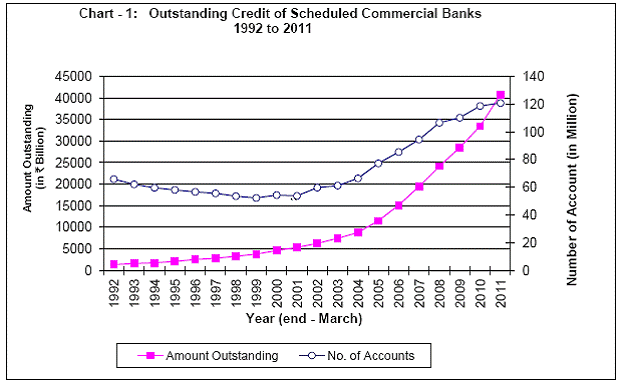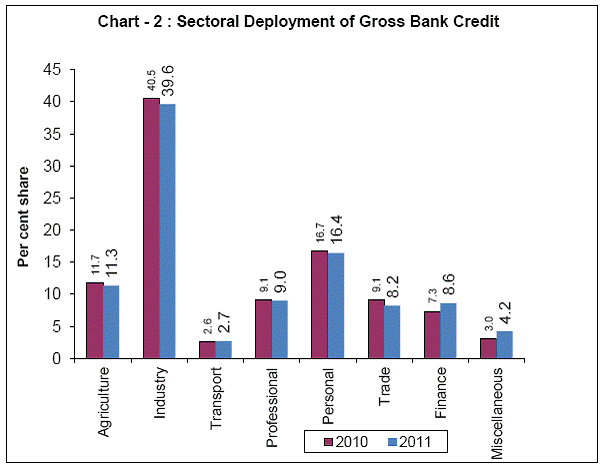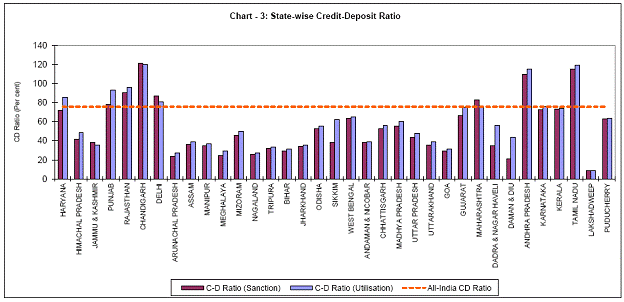1. The publication ‘Basic Statistical Returns of Scheduled Commercial Banks in India’ -Volume 40 is based on data collected through BSR 1 and 2 surveys as on March 31, 2011, which covered 92,117 offices of scheduled commercial banks including regional rural banks. These returns are required to be submitted by each branch/office of a scheduled commercial bank in India. The salient findings based on finalized data for the publication are set out below:
Outstanding Credit of Scheduled Commercial Banks:-
2. Growth of gross outstanding credit:
-
At the end of March 2011 gross outstanding credit of scheduled commercial banks amounted to ` 40,756,470 million registering an increase of 21.8 per cent as against an increase of 17.5 per cent in the previous year (Table No.1.3).
-
The number of borrowal accounts increased to 121 million in 2011* from 119 million in 2010*, i.e. by 1.8 per cent (Table No. 1.3).
3. Population group-wise distribution of credit:
-
Metropolitan and Urban centers had the highest credit growth at 22.4 per cent, each, in 2011 followed by the Semi-urban which recorded a growth of 19.3 per cent. Rural centers witnessed growth in credit at 18.7 per cent in 2011. (Table No. 1.3)
-
Of the incremental credit, during 2011, Metropolitan centers has highest share at 68.0 per cent. The share of urban, semi-urban and rural was at 17.2, 8.4 and 6.4 per cent respectively.
4. Bank group-wise distribution of credit:
-
The share of the nationalized banks in total bank credit increased further to 53.0 per cent in 2011 from 52.0 per cent in 2010. Correspondingly, the share of SBI group declined from 23.1 per cent to 21.9 per cent in 2011. The share of other bank groups remained almost unchanged (Table No.1.4).
-
The nationalized banks had the highest credit growth at 24.3 per cent in 2011 followed by the private sector banks which recorded a growth of 23.9 per cent. The SBI & associates and regional rural banks witnessed growth in credit at 15.3 and 18.6 per cent in 2011, respectively. Foreign banks recorded a credit growth of 21.0 per cent,
-
Of the incremental credit, during 2011, SBI & Associates, nationalized banks and private sector banks shared 16.3 per cent, 57.8 per cent and 19.2 per cent, respectively.
5. Sectoral (occupation wise) deployment of bank credit:
-
The share of agriculture credit in gross bank credit was 11.3 per cent compared with 11.7 per cent in 2010. The share of credit to industry also reduced moderately (to 39.6 per cent from 40.5 per cent in 2010). (Table 1.11 and Chart 2).
-
The share of personal loans decreased to 16.4 per cent of gross bank credit in 2011 from the level of 16.7 per cent in the previous year.
-
The share of credit to finance increased to 8.6 per cent in 2011 as against 7.3 per cent in 2010.
6. Sectoral (Occupation wise) credit gowth:
-
The growth rate of bank credit to agriculture declined to 18.1 per cent in 2011 from 26.1 per cent in the preceding year (Table 1.9).
-
The growth of credit to industry declined to 18.9 per cent in 2011 from 19.5 per cent recorded in 2010.
-
Personal Loans registered an increase of 19.9 per cent in 2011 compared to 1.0 per cent in 2010. Housing loans, which forms a part of personal loans increased by 12.9 per cent compared to 7.6 per cent in the previous year. Education loan increased by 22.4 per cent in year 2011.
7. Sectoral (Occupation wise) share in incremental bank credit:
-
The industry sector, with 44.4 per cent share in the incremental credit in 2010, continued to capture the highest share in 2011 at 35.2 per cent.
-
The agriculture sector absorbed about 9.7 per cent of the incremental credit in 2011 compared to 16.3 per cent in 2010.
-
The personal loans accounted for 15.2 per cent of incremental credit compared to 1.1 per cent registered in the previous year. Housing loans accounted for 5.4 per cent compared to 4.3 per cent registered in the previous year.
-
The share of credit to professionals in the incremental credit at 8.6 per cent declined from 11.4 per cent recorded in 2010.
8. Size-wise distribution of bank credit:
-
The number of small borrowal accounts (with credit limit up to ` 0.2 million) contributed to 84.6 per cent of total number of accounts as against 86.5 per cent in 2010, while the share of outstanding credit of small borrowal accounts was 9.4 per cent as compared to 10.8 in 2010 (Table No.1.12).
-
Accounts with credit limit above ` 250 million each contributed to 47.3 per cent of the outstanding credit in 2011, which is higher than 43.7 per cent observed in the previous year.
9. Interest rate on bank credit:
-
The distribution of outstanding credit according to interest rate ranges (available for accounts each with credit limit of over ` 0.2 million) revealed that the proportion of outstanding amount was the highest at 54.4 per cent in the range of 6 – 12 per cent (Table No. 1.13).
-
The weighted average interest rate in respect of all loans and advances with credit limit of over ` 0.2 million worked out to be 11.4 per cent as at the end of March 2011 as compared to 10.5 per cent in the previous year.
Aggregate Deposits:-
10. Growth in aggregate deposits:
-
Aggregate deposits amounted to ` 53,895,513 million, registering a growth of 18.2 per cent in 2011 as against 16.3 per cent a year ago (Table No.1.18).
-
The number of deposit accounts in 2011 increased by 10.2 per cent to 810 million from about 735 million in March 2010. Total number of savings bank account was at 624 million in 2011.
11. Bank group-wise distribution of deposits:
-
The share of nationalized banks in aggregate bank deposits rose further to 53.2 per cent in 2011 from 51.9 per cent in 2010. The share of SBI & Associates declined to 21.4 in 2011 from 22.3 per cent in 2010 (Table No.1.4).
-
The deposits of the nationalized banks registered the highest growth of 21.1 per cent followed by the private sector banks (20.5 per cent) and regional rural banks (15.3 per cent) in 2011.
12. Type of deposits:
13. Maturity pattern of term deposits:
-
The share of term deposits with original maturity period of 5 years and above in total term deposits increased to 8.8 per cent in 2011 from 8.3 per cent in the previous year. Also, deposits with maturity ‘1 year to less than 2 years’ and ‘2 years to less than 3 years’ witnessed increases in their shares to 40.8 per cent (from 37.9 per cent in 2010) and 12.8 per cent (from 12.3 per cent in 2010) respectively. (Table No.1.24).
14. Interest rate on term deposits:
-
The weighted average interest rate of term deposits worked out to 8.3 per cent in 2011, as compared to 7.0 per cent as at end-March 2010 (Table No.1.28).
-
The percent share of term deposits with interest rate less than 6 per cent in total term deposits decreased to 7.8 per cent in 2011 from 24.0 per cent in the previous year. Also deposits with interest rate 6 per cent to 8 per cent and 8 per cent to 10 per cent had shares 31.4 percent (compared to 48.8 per cent in 2010) and 44.6 per cent (from 19.1 per cent in 2010) respectively. (Table No.1.28).
Credit - Deposit Ratio:-
(As per Place of Sanction and Place of Utilization of Credit)
15. Population group-wise C-D Ratio:
-
The All-India C-D ratio was at 75.6 per cent in 2011 compared to 73.3 per cent in 2010.
-
The population group-wise C-D ratio in respect of rural centers at the end of March 2011 was at 60.0 per cent as per place of sanction of credit compared to 59.3 per cent in the previous year. In the case of semi-urban and urban centers the C-D ratios were 53.2 per cent and 61.6 per cent respectively compared to 52.1 per cent and 59.1 per cent in the previous year.
-
The C-D ratios as per place of utilization for rural, semi-urban and urban centers were 79.6 per cent, 63.1 per cent and 70.2 per cent, respectively, compared to 91.6 per cent, 59.9 per cent and 62.8 per cent, respectively, in the previous year. The C-D ratio recorded in metropolitan centers as per place of sanction and utilization was 88.4 per cent and 79.9 per cent respectively in 2011 (compared to 85.9 per cent and 77.4 per cent, respectively, in 2010) (Table No.1.6).
16. Bank group-wise C-D Ratio:
-
The C-D ratio of SBI & associates was at 77.3 per cent in 2011 compared to 75.9 per cent in the previous year while C-D ratio of nationalized banks was at 75.9 per cent (compared to 73.5 per cent).
-
The C-D ratios of foreign banks (85.0 per cent), regional rural banks (59.9 per cent) and Private sector banks (74.7 per cent) have increased in 2011 from their levels in the previous year (72.9 per cent, 58.3 per cent and 72.7 per cent respectively).
17. Migration of credit among the states:
-
An analysis of migration of credit among the states has been done through the Credit Deposit ratios, calculated as per the place of sanction of credit and place of utilization of credit (Table No. 1.7 and Chart –3).
-
Haryana, Punjab, Gujarat, Rajasthan, Andhra Pradesh & Tamil Nadu had higher C-D ratios as per place of utilization than place of sanction. On the other hand, Maharashtra and Delhi had lower C-D ratio as per place of utilization.
-
As compared with 2010, C-D ratio as per place of utilization increased noticeably in Haryana, Punjab, Delhi and Sikkim. On the other hand, C-D ratio declined moderately in the Northern-eastern states.
|
 IST,
IST,




















